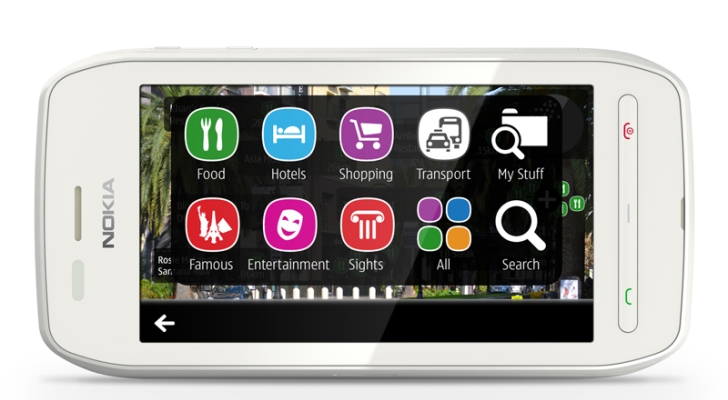How does Apple's iOS 7 compare to Google's
Android 4.2 Jelly Bean? We take a look at both to check the lay of the land.
Interface
Android’s interface has utilised a similar look and feel since version 4.0 Ice Cream Sandwich (and to an extent 3.0 Honeycomb) which was introduced by Mathias Duarte. This comprises a black notifications bar and black or grey menu backgrounds, but the rest of the interface elements are largely either translucent, white or cyan throughout and use Google’s unique Roboto font. Google’s app icons use a very simplified art style, similar to vector art with bold, flat colours and some selective highlights and shading in some places.
- iOS 7 release date & features confirmed
- Google Play Music All Access service launched at Google I/O
Overall it’s very clean, cohesive and minimalist, which I rather like.
I wouldn’t be the first to suggest that with iOS 7, Apple has taken some ‘inspiration’ from Android for the new look. Admittedly though, in some ways it has gone one better. The top bar is no longer black and is now transparent, rather like Google’s persistent search bar widget. It actually looks nicer than Google’s black bar in my view.
The app bar at the bottom is no longer a reflective ‘pane’ for the apps to sit on and is instead another translucent section and this is distinctly different from Android – which doesn’t have a bar and simply features a grey dividing line.
Apple has revamped folders in iOS 7 which can now be packed full of app shortcuts and scrolled through. However, I don’t find the implementation as compelling as Android’s system. In iOS 7, tapping on a folder zooms you in on it and takes you, effectively, to a whole new homescreen. For me, this isn’t what folders are about and I think Android’s system where the folder expands over part of the screen as a temporary overlay is much better.
Apple’s app icons have been tweaked in a similar fashion to Google’s with that ‘flatter’ aesthetic which was rumoured. They still have gradient colours but there’s less shadowing, less gloss and everything is generally much more simplified. Text is also flatter with no shadowing underneath.
While it’s fair to say that Android has its share of bright and clashing colours I think Apple has taken it to a whole new level and there’s something very retina-searing about iOS 7’s colour scheme which, to me, sits at odds with that theme of soft white text and translucent menu elements. This was calling out for a more nuanced palette, in my opinion.
Multitasking
Multitasking has been completely overhauled on iOS 7 but to say it takes a leaf out of Android’s book is an understatement. It’s pretty much a wholesale copycat affair, complete with a scrollable carousel of active app preview panels of the kind we’ve seen since Honeycomb 3.0 and, importantly, the same ‘swipe-to-close’ gesture Android has been using since version 4.0 Ice Cream Sandwich.
It scrolls side-to-side in ‘portrait’ orientation (similar to Windows Phone 8, in fact) and the swipe to close is upwards, as opposed to Android’s up-and-down carousel and swipe to the side to close, but for all intents and purposes it’s the same setup with a slightly different skin (ie: Apple’s new ‘everything is translucent’ approach).
I really love Android’s multitasking so I have mixed feelings on the subject. On the one hand, it’s great to see that I can get that same interaction style elsewhere, but on the other: this isn’t the only way multitasking could’ve been implemented, as BlackBerry 10 proved. In fact, BlackBerry 10 has largely convinced me there are better approaches than Android. There is more than one way to multitask well.
As a result, Apple’s straight-up burglary is pretty shameful on all fronts –it’s blatant copying and is both unimaginative and unoriginal where the firm had a chance to show its creativity.
Notifications
Both iOS 7’s and Android’s notifications centres drop down from the top bar with a swipe gesture.
With Android you have a black background which you can just about see app icons behind. The clock appears bigger than in the closed bar and shifts to the left-hand side while a toggle on the right corner lets you switch back and forth Quick Settings menu. Individual notifications appear in little boxes and can be swiped away to dismiss.
On iOS 7 you have a translucent background, the top bar remains as it is on the homescreen and there are three categories at the top for ‘Today’, ‘All’ and ‘Missed’. Notifications appear as a continuous stream only separated by a small icon and text showing what app they’re relevant to, such as ‘Calendar’, for example.
Quick Settings
Quick Settings on Android can be opened by swiping down from the notifications bar with a two-fingered gesture and presents you with a grid of square button toggles for things like brightness,
Wi-Fi and
Bluetooth – there’s also a shortcut to the full-fat Settings menu.
Google’s take on the Quick Settings menu, something pioneered by third-party manufacturer UIs and launcher apps on its
platform, was a long time coming from when the concept first emerged and still hasn’t quite lived up to what the ‘Android community’ came up with first, in my view. It’s not so instantly accessible.
Conversely, Apple appears to have actually done a really good job here. The ‘Control Centre’, as it’s called, swipes up from the bottom and continues the translucent theme.
You’ve got a standard set of toggle shortcuts for Bluetooth, Wi-Fi and the like, but more importantly an actual brightness slider, which is annoying absent from stock Android even now. There’s also a handy music player widget, er, thing, for any current track you’re listening to, a button for AirPlay and AirDrop and a set of shortcuts for calculator, flashlight and camera functions.
Core apps and services
iTunes Radio vs Google Play Music: All Access
One of Apple’s big announcements for WWDC was iTunes Radio, the much-rumoured music streaming service which expands on Apple’s existing iTunes setup to allow ‘featured stations’ of streamed content.
Google Play Music: All Access is pretty much exactly the same setup, as we wrote during Google’s announcement:
‘All Access has a wide-ranging catalogue of music using Google Play’s existing setup, but you can stream tracks instantly. It also features ‘expert curated’ genre lists showing iconic genre tracks and allowing you to discover new music.’
If you tap on a track to play it you can turn it into a radio station - All Access will pull in a ‘never-ending’ playlist of related tracks and stream them to your device. You can swipe to peek at what track is coming next or access the playlist completely - if there’s anything on there you don’t like you can swipe it away or you can re-oder the playlist as you like.’
iTunes Radio does include a few extra perks, such as Siri integration, as Apple’s Eddie Cue outlined at the launch:
‘Let Siri make your listening experience even more fun. Ask Siri ‘Who plays that song?’ or ‘Play more like this’ and Siri will make it happen. Say something like ‘Play Jazz Radio’ or ask for any of your existing favourite stations and genres. Shape your stations by telling Siri what you like and don’t like, or tell Siri to pause, stop or skip. You can also have Siri add songs to your Wish List to download later.’
Both services are coming in later then entrenched competitors such as Spotify and both have massive collections of licensed music to offer.
As usual, it’s simply a case of selecting one ecosystem or another to become entrenched in, and such a decision should probably centre around other software and hardware considerations more than anything else.
Like the iPhone’s design? Go with iTunes Radio. Prefer the Android interface? Pick Google Play Music: All Access. It really makes little difference.
Each is also initially only available in the US, however, and we’ll have to wait a little while before either makes its way across the pond.
Apple Maps vs Google Maps
In terms of updates for Apple Maps we were once again shown all the ‘amazing’ 3D stuff again. As far as more useful stuff is concerned Apple demonstrated how you can now select a location, find points of interest, see reviews for said POIs and share the location via social networking, messaging or to your phone from a computer. So far, so playing catch-up to Google Maps.
Apple didn’t really demonstrate much in the way of improved location data and accuracy though. Sure, there weren’t any gaping voids in the big-screen demonstration, but then, there wouldn’t be. For now, we know from experience that Google Maps is excellent, the standard by which others are measured, because the company has invested a lot of time, money and effort over the years to literally re-map a massive chunk of the planet, on the ground and in the air. Until more extensive use tells us that Apple Maps has caught up in this regard, I’ll continue to trust Google Maps first.
On a related note, Apple did explain how it was working with car manufacturers to integrate both Apple Maps and Siri voice commands into in-car systems. Quite how far-reaching this will be in terms of participating manufacturers and supported car models isn’t clear.
At first I’d guess this will have a US focus, but in any case given Apple Maps’ recent history I’m not exactly champing at the bit to have it guiding me while driving and I’m sure plenty of Australians can say the same.
Lock screen
As this side-by-side screenshot shows, the two lock-screen interfaces are alarmingly similar, right down to the stock wallpaper. Android got here first, of course.
In terms of functionality both offer the same deal. Notifications appear on the screen, you can access the camera from the lockscreen and both feature swiping gestures to unlock (although of course you can replace these with passcodes and the like.) Both also allow you to access their respective quick settings and notifications screens from the lockscreens with the same gestures you’d use on the normal homescreen.
Conclusion
As I’ve hinted at earlier in the comparison, it’s difficult in many ways to see iOS 7 as anything other than Apple playing catch-up to Android, while snagging a few choice morsels from Windows Phone and BlackBerry 10 along the way.
In many respects that’s fair enough, but these things are not revolutionary in the broader sense – massive bonuses for people already entrenched in iOS, of course, but Apple and its followers are in no position to be crowing about revolutionising the
smartphone space. Though that won't stop them from doing so anyway.
But this is all politics, what about if you’re sat there wondering which platform to invest in? And to be clear, when I say invest, I really do mean invest – if you’re going to be buying films, music, games and apps on either of these platforms then making a switch later with your collection intact is going to be difficult at best and in some cases impossible at worst.
Such profound wisdom on which is the better long-term bet would require some kind of crystal ball and the clairvoyance to see where both companies and their ecosystems are headed, so I’m afraid I can’t help you there. I left mine at home.
What I can say is that I prefer most of Android’s overall aesthetic, mainly as the colours are less offensive to my delicate eyeballs, however I do also prefer iOS 7’s translucent menu elements and in particular the Control Centre has utterly schooled Google on how it should be done. I’d also reiterate that I don’t trust Apple Maps any further than I can throw it, and I’m rubbish at throwing stuff.
Both platforms have massive, thriving ecosystems packed with app and multimedia content, both also now have streaming services built-in and both have slick, multitasking-friendly interfaces.
You could argue you get more choice in terms of hardware on Android, that’s very true and in many ways is a good thing, but on the flip-side Apple doesn’t get treated to lots of annoying UI overlays sullying the experience and there’s one clear choice of the ‘best’ handset when it comes to the platform.
In short: ‘you pays your money, you takes your choice,’ as they say.
 Gary McKinnon: The Extraordinary Hacker
Gary McKinnon: The Extraordinary Hacker






































